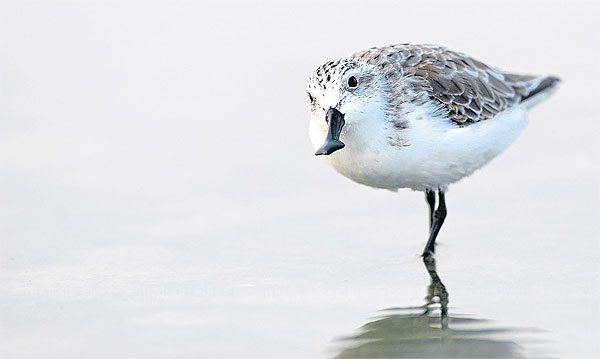-
Launch of the Chinese Version of the IUCN situation analysis on East and Southeast Asian intertidal habitats
January 23, Beijing – the Chinese version report of the IUCN situation analysis on East and Southeast Asian intertidal habitats, with particular reference to the Yellow Sea (including the Bohai Sea) was launched together by the International Union for Conservation of Nature (IUCN) and the Partnership for the East Asian – Australasian Flyway (EAAFP). […]
Continue reading -
Nearly 20 years old Whimbrel observed at Sungei Buloh Wetland Reserve
Whimbrel A8 observed at Sungei Buloh Wetland Reserve – Reported by David Li and How Choon Beng of SBWR team. During the migratory season between August to March, Sungei Buloh Wetland Reserve (SBWR) conducts fortnightly ringing sessions. On 29th Jan 2014, the team netted 4 Whimbrels amongst the other birds. One of these Whimbrels was […]
Continue reading -
Birds Korea Scaly-sided Merganser Survey
Posted on: January 27, 2014 Author: Nial Moores PhD Report by Birds Korea A total of 149 Scaly-sided Merganser Mergus squamatus were recorded nationwide by the Birds Korea survey, conducted between January 5th and 22nd 2014. This number is remarkably similar to the 140-149 recorded by our survey work in February 2012, despite much greater survey effort this year, […]
Continue reading -
조류 인플루엔자 및 야생조류 학술대책위원회 성명문
조류 인플루엔자 및 야생조류 학술대책위원회 성명문: 대한민국의 가금류 및 야생 조류에서의 고병원성 조류 인플루엔자 H5N8에 대하여 2014년 1월 주요 메시지 고병원성 조류 인플루엔자 (HPAI)는 가금류 생산 시스템과 이의 가치 사슬과 연관되어 있습니다. H5N8 HPAI가 최근 대한민국의 국내 가금류로부터 알려졌으며 가금류 및 야생 조류의 사망을 유발하였습니다. 가금류 산업뿐만 아니라 가창오리 무리를 포함한 […]
Continue reading -
철새, 조류독감의 원인이 아닌 피해자
이번 주 전라북도 오리 농장에서 조류독감이 또 발병함으로써 우리는 질병 전파에서의 철새의 역할에 대한 일반적인 추측과 잘못된 정보에 노출되어 있음을 알게 되었습니다. 특별한 증상을 보이지 않는 저병원성 조류 인플루엔자 (LPAI)는 야생조류 및 가금류에서 자연적으로 발생됩니다. 이와 반대로 이번 전라도에서 보고된 H5N8와 같은 고병원성 조류 인플루엔자 (HPAI)는 일반적으로 오리농장과 같이 매우 좁은 공간의 비자연친화적 환경에서 […]
Continue reading -
Arctic geese benefiting from climate change
Posted on: January 27, 2014 Author: Horton et al Report by Birdguides Scientists with the U.S. Geological Survey report that warming temperatures are leading to the creation of high-quality habitats for geese along the Arctic coast of Alaska. This scientific finding is contrary to the deleterious effects that warming global temperatures are having on habitats […]
Continue reading -
Planned reclamation opposed
Posted on: February 9, 2014 Author: Charissa Luci Report by Manila Bulletin Senator Cynthia Villar continued to oppose the planned reclamation of the Las Piñas–Parañaque Critical Habitat and Ecotourism Area. In joining the celebration of the “World Wetlands Day,” she batted for the conservation of the area, included in the Ramsar List of Wetlands […]
Continue reading -
Making The Welcome Warmer
Posted on: January 22, 2014 Author: Amorn Liukeeratiyutkul, Gawin Chutima & Philip D. Round Report by Bangkok Post Greater efforts will be needed, both at home and abroad, to prevent the extinction of a plucky little bird which breeds in Russia and then makes a marathon annual migration to Southeast Asia Does it […]
Continue reading -
WWT: Spoon-billed sandpipers arrival at Heathrow
A quick compilation of footage of the arrival of the spoon-billed sandpipers at the City of London Corporation’s Animal Reception Centre at Heathrow Airport and on to WWT’s headquarters at Slimbridge.
Continue reading -
国际禽流感与野鸟工作小组的声明
国际禽流感与野鸟工作小组对 「韩国家禽养殖场及野鸟发生 H5N8 高致病性禽流感」所发出的声明 2014 年 1 月 重点讯息: 1. 大部分高致病性禽流感(HPAI) 的暴发,均与家禽养殖场系统及其有紧密关系的 “价值链”(相关服务或活动)[1] 有关。 2. 近日韩国的家禽养殖场出现 H5N8 高致病性禽流感病毒,并导致家禽及野鸟死亡个案发生。 3. 疫情除了影响家禽养殖业,亦可能导致大量野鸟死亡, 当中最值得留意是有花脸鸭[2]集体死亡。 4. 目前并没有证据显示野鸟是此病毒的来源,它们应只被视为受害者,而非病毒携带者。 5. 由联合国环境署/迁徙物种公约(UNEP/CMS)[3] 与联合国粮食及农业组织(FAO)[4]联合召集的国际禽流感与野鸟工作小组(以下简称: 禽流感工作小组)[5]促请各政府部门及机构: a. 进行全面的流行病学评估以确定病毒的真正来源,与及家禽跟野鸟之间的病毒传播机制; b. 无论感染来源如何,应先专注处理受影响的家禽养殖场的疾病防控工作,以尽量减低疾病蔓延至其他家禽养殖场及/或野生动物的风险; c. 确保受影响的家禽养殖场与邻近地方实施生物防护[6],以防止野生动物与养殖家禽接触;和 d. 需留意若公众注意力集中在野鸟身上,会令原本应集中用来处理疾病防控工作的力量错误地被分散,并将会对野鸟保护工作产生负面影响, 及导致生物多样性的受损。 当前情况: 据韩国相关报道,当地首个H5N8高致病性禽流感暴发于2014年1月16日,位于韩国全罗北道高敞郡[7],距首尔东南面300公里的养鸭场内。之后又有数个野鸟死于H5N8的个案报道。至今已有大量花脸鸭 (Anas formosa)及少量豆雁 (Anser fabilis) [8]死亡,当中部分尸体对H5N8病毒测试呈阳性反应。最少在17个家禽养殖场验出H5N8病毒,另外有大量怀疑案例正进行检测中。 超过640,000只家禽已被宰杀,之后将会有更多养殖家禽开始被销毁,数目估计超过数十万,甚至数百万。 病毒源于何处? 直至现时为止,全球众多野鸟监察小组仍未发现过 H5N8 禽流感病毒存在于野鸟中。研究人员正尝试找出引起是次禽流感暴发的病毒来源。部分人士猜测此病毒是由野鸟散播,但这言论至今仍没有任何流行病学证据支持。虽然有个案显示病毒导致野生豆雁及花脸鸭死亡, 但因花脸鸭偏好混于数目由数万至数十万只野鸟组成的群落中栖息, 故此若花脸鸭是病毒来源的话,病毒理应早于这个冬季已在野鸟群中传播, 并导致更多的死亡个案发生。另外要留意的是花脸鸭早于 2013 年秋季已飞抵韩国,可是在家禽养殖场疫症暴发之前却并没有任何疫症发生的迹象。相对于在家禽养殖场及相应经济“价值链”内的养殖禽鸟,高致病性禽流感病毒极少在野鸟身上被验出。家禽养殖场及其经济“价值链”上的作业相信是让低致病性病毒有机会发生基因突变、然后演化成高致病性病毒,并导致病毒迅速扩散的温床。 无论是已受影响的家禽养殖场场内,还是养殖场之间一切有关家禽、禽鸟产品、从业员及用具的往来运输,与及场内的废料向周边环境外泄,均会促使病毒扩散并感染其他家禽及野鸟。 应采取什么行动? […]
Continue reading


